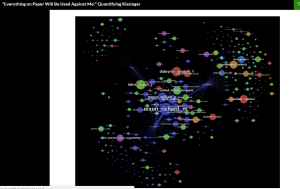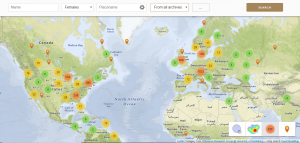Because of the new wave of technology, people are able to gather more information and have it become more accessible to a larger audience. The ability to access a plethora of resources on various subjects gives digital archives an advantage over archival documents. It is more time efficient to access documents on an online database than searching through a physical collection of printed documents. Search mode enables people to save time by instantly looking up whatever information rather than manually looking through each print. Another advantage to creating digital versions of documents is the fact that physical documents deteriorate over time due to weathering and physical handling. However, a disadvantage of creating digital artifacts is losing the authenticity of the original works. The physical and written structure of printed documents and the style of handwriting get lost in translation when they are turned into digital artifacts. Due to this, learning about a period’s culture is not possible because of the disappearing evidence of handwriting styles, writing styles, etc.. The way people write shows the cultural expectations for that time period. For example, flowery poetry was popular from the late 1700s to the 1900s in Britain and the United States. Knowing the long, wordy style of “flowery poetry” it indicates what those cultures valued: artistic and emotive expression. Although digital documents can use visualization like word clouds to show the most commonly used words in a document, it does not show the adjectives in between which distinguishes flowery poetry from other styles. In terms of what kind of knowledge digital archives offer, they give people access to a multitude of documents from all time periods which enables them to make connections over long periods of time unlike physical archives which are more tiring to look though.
It is hard to answer the ultimate question of which method is better because each has its own advantages and disadvantages. However, the way people read digital versus print documents is different. So in a sense, digital artifacts do supplant our needs for print because visualization tools like word pattern graphs and text images that use shape, color, texture help the mind process the digital information better. However, reading online documents by browse and search mode encourages readers to skim and search for the information they want instead of reading slowly. Print documents require inspection, sift, and synthesis because they do not include visualization like word clouds. Close reading is a good skill for understanding the little nuances in a text and aids in understanding the information on a deeper level since it focuses on word choice and phrasing. To encourage that in digital texts, it might be effective to not put in so many images that it distracts the reader from reading the text itself. It is easy to mistake those images as conclusions themselves rather than a means to a conclusion.
Comparing the Moravian Lives project with other large DH projects, similarities like categorizing documents. The Moravian website has a map which enables the reader to visualize where the documents originate from. They are also categorized by language, country and archive. Quanitfying Kissinger also uses network analysis to visualize all the information sourced from the documents for comparison. Because large DH porjects have large quanitities of data, they use distant reading to visualize patterns to understand the overarching ideas.


